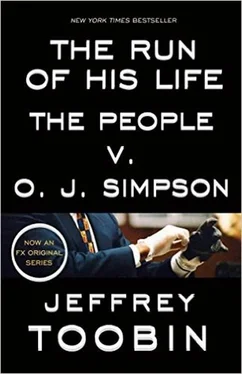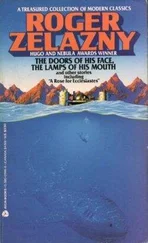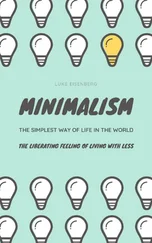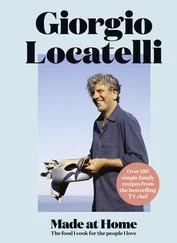To call the forty-two-year-old Huizenga boyish does not do justice to the curiously unlived-in look of his face. He could have passed for a college student. Blandly handsome, blond, and fit, he seemed like a West Coast Dan Quayle. Huizenga had impeccable credentials-summa cum laude graduate of the University of Michigan; degree from Harvard Medical School; former chief resident at Cedars-Sinai Medical Center in Los Angeles; former team physician for the Los Angeles Raiders football team-yet it was precisely because of his eminent qualifications that his testimony and demeanor seemed so shocking. For it became clear, as soon as Shapiro called him to the stand, that Huizenga was completely in O.J. Simpson’s thrall. In Los Angeles, it seemed, it wasn’t just the Ron Shipps of the world-the hangers-on, the wannabes-who worshipped the local celebrities. Even Rob Huizenga, with all his fancy credentials, was willing to sacrifice his objectivity, his probity, and even his dignity to ingratiate himself with a famous man, even one accused of murder.
Huizenga was so eager to testify that he frequently cut off Shapiro before he could even finish his question. According to Huizenga’s examinations of Simpson on June 15 and June 17 (at Kardashian’s house, just before O.J. and Cowlings disappeared), Simpson suffered, the doctor said, from a “whole array of the typical post-NFL injury syndromes.” He had a pair of bad knees, a bum right ankle, and a case of arthritis. “On the day I saw him, he had significantly limited mobility,” Huizenga said. “Fast walking, certainly in terms of slow jogging, it would be very difficult if not impossible.” Huizenga also showed the jury the photographs of Simpson taken during the examination of June 17: His torso was massive and hugely muscled, but Shapiro pointed out that he had no abrasions to suggest he had just fought a life-or-death struggle less than a week earlier.
In his breezy way, Shapiro asked whether the photographs didn’t show “a man to be in pretty good shape.”
Huizenga helpfully disagreed. “Curiously, some people have these phenomenal builds and really aren’t in all that great aerobic shape. And I think that, based on my history, he hadn’t really been doing much exercise, if any, and there are some very lucky people that looks can be deceiving and certainly in his case, although he looks like Tarzan, you know, he was walking more like Tarzan’s grandfather.”
Brian Kelberg, the former medical student who had examined Lakshmanan at such length, conducted what was possibly the best cross-examination of the entire trial. Kelberg began by exploring the question of bias. Huizenga had agreed that he had been hired by Shapiro under highly unusual circumstances, and Kelberg asked whether the doctor had viewed his role as “to start preparing a possible defense in the event Mr. Simpson was charged.”
Huizenga pouted and disagreed. “I took it to address his mental problems, insomnia, and difficulty handling this incredible stress that maybe no other human being, short of Job, has endured.”
There was a pause in the courtroom as lawyers on both sides did double takes, as if to assure themselves that Huizenga had really said what they thought he said. (Even the somnolent jurors perked up at the reference to Job.)
Kelberg knew just how to follow up. “I want to be clear in your answer,” he said. “Is it your characterization that Mr. Simpson is in a situation which, to your knowledge, only Job has suffered more?”
“I think the pressure that was on him, for whatever reason, was a tremendous weight, the change in his life status that very few, if any, people have experienced in my opinion,” Huizenga answered.
“And if he had murdered two human beings, Nicole Brown Simpson and her friend Ronald Goldman, would that be the kind of thing that would cause a great weight to be on a man’s shoulders?”
Shapiro objected in vain, and Huizenga had to say, “If someone hypothetically killed someone, they certainly would have a great weight on their shoulders.”
As Kelberg continued, Huizenga strained to spin every answer in Simpson’s favor. Kelberg brought out that Huizenga had written Shapiro a series of letters in which he, a nominally independent expert, had helped Simpson’s lawyer plot legal strategy. Kelberg showcased Huizenga’s preening ego for the jury, showing how the doctor larded up his résumé with his talk-show appearances. In answer after answer, Huizenga struggled to shade his answers to help the defense. It was an astonishing, and appalling, performance.
Even on the substance of the case, Kelberg used Huizenga to his advantage. The prosecutor meticulously went over the photographs of Simpson’s hands that were taken on June 17, and revealed to the jury that Simpson actually had seven separate abrasions on his left hand and three different cuts. His right hand was unmarked. (This fit with the prosecution’s theory that Simpson lost his left glove during the struggle at Bundy, cut his left hand, and did not lose his right glove until he returned to Rockingham.)
But Kelberg was just warming up. He showed a video clip from a motivational speech Simpson had given on March 31, 1994-a little more than two months before the murders-for an arthritis-relief product called Juice Plus. (Among other things, this demonstrated just how low Simpson had sunk in the entertainment world; once he had made Hertz commercials for national television, now he was pitching for a questionable medical remedy at a shabby convention in Dallas.) Mugging for the cheering distributors, Simpson said, “I started taking regularly Juice Plus and started feeling-I don’t know if it was mind over matter, if it was a mental thing-but almost immediately I started feeling better all of a sudden. I was starting to get another ten yards on my drive!” Confronted with the tape, Huizenga had no choice but to speculate that Simpson was either lying to push the product or in fact had enjoyed some relief from his arthritis symptoms.
But the climax of Kelberg’s cross-examination came when he played seventy minutes of raw footage from an exercise video that was later released as O.J. Simpson Minimum Maintenance for Men . Simpson had taped the routine-in which he looked fit and healthy in a T-shirt and Lycra shorts-at the end of May 1994, just two weeks before the murders. Trading inane patter with the coach who was directing the exercises, Simpson looked like a model of middle-aged fitness. Simpson stretched; he marched, bent his knees, did push-ups and sit-ups. The tape alone scotched the notion that Simpson did not have the physical ability to murder his ex-wife and her friend.
The most remarkable part of the tape came so fast that it was possible to miss it the first time through. One of the routines involved the participants simulating a punching motion-right jab, left jab, right jab, left jab. As the coach on the videotape later testified, Simpson ad-libbed a narration to the punching portion of the exercise. “Get your space in if you’re working out with the wife,” Simpson said to the camera, still punching at the air with his thick, muscled arms. Then he chuckled and added, “If you know what I mean, you can always blame it on workin’ out.” Meaning, if you punch your wife, you can always blame it on working out.
A convicted wife beater jokes about beating his wife. Could there have been a more chilling glimpse into O.J. Simpson’s subconscious? (The jurors, it turned out from later conversations, never paid any attention to this. Indeed, they said little about the defense case at all, so exhausted and numb were they by the summer months. By this point, it appears, they had already made up their minds.)
The defense case, then, ranged from poignant (Simpson’s family) to pathetic (Huizenga) to irrelevant (Baden and Lee) to downright incriminating (Heidstra and the exercise video). What many of the witnesses had in common was that their testimony pained them, embarrassed them, or otherwise diminished them.
Читать дальше












